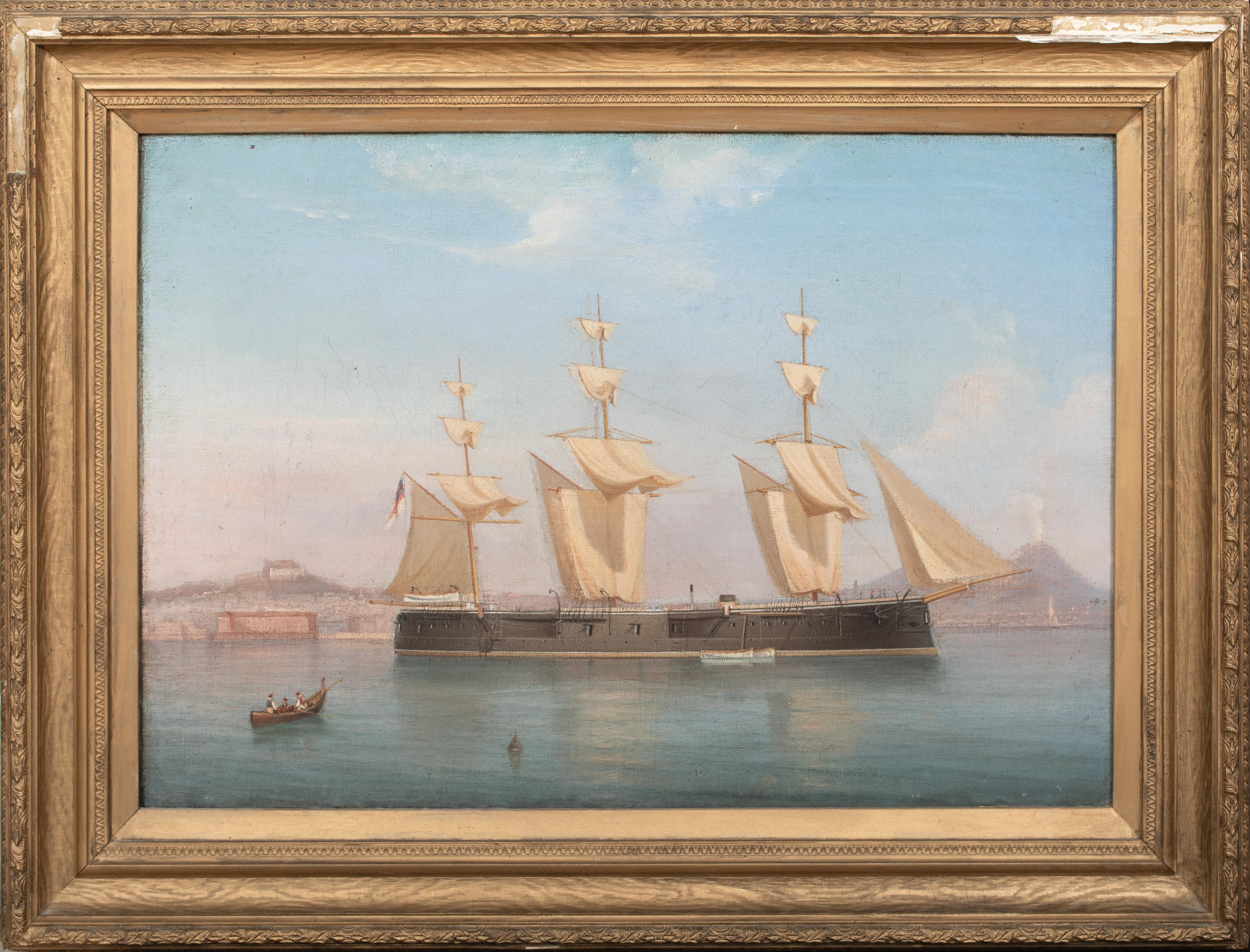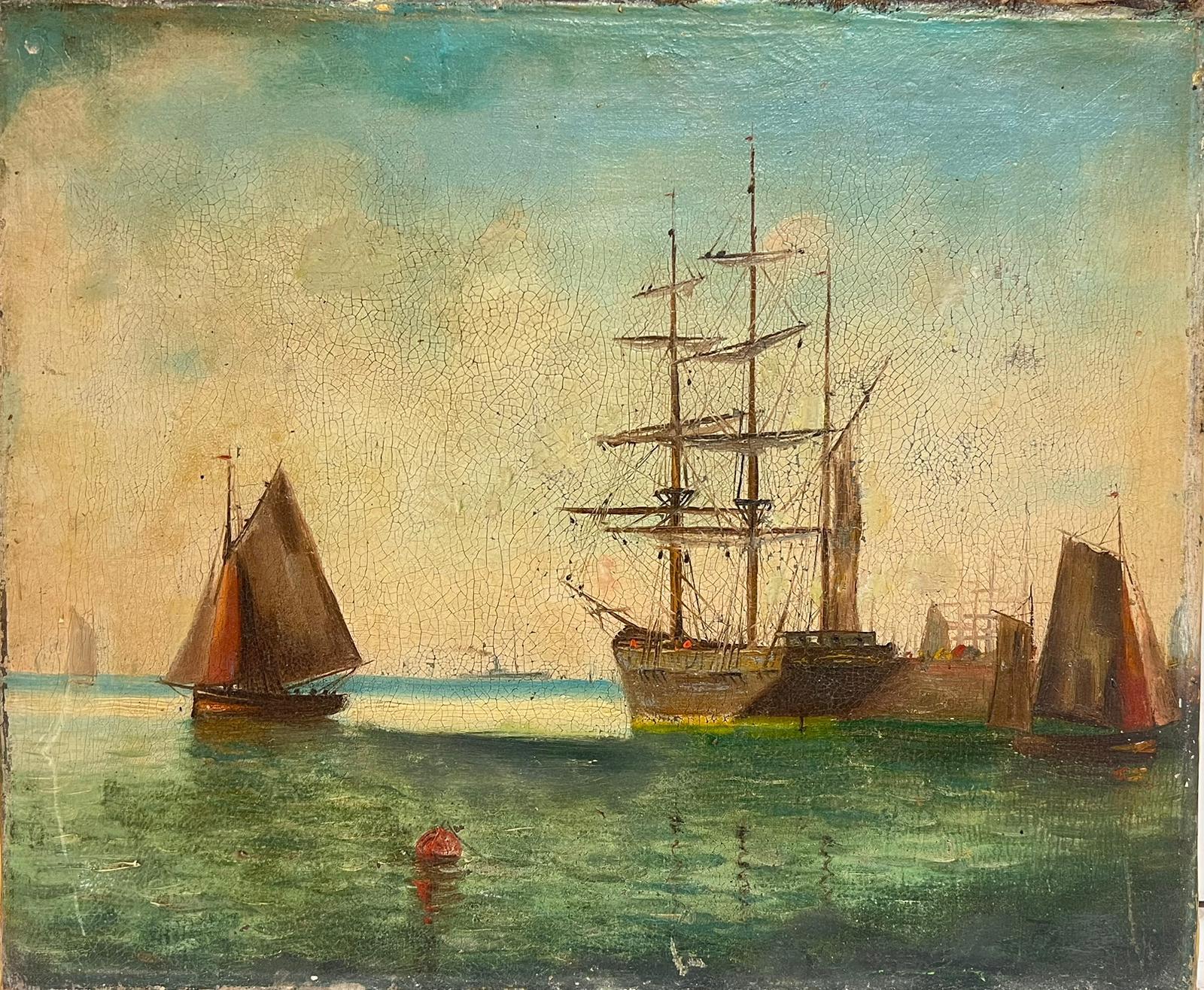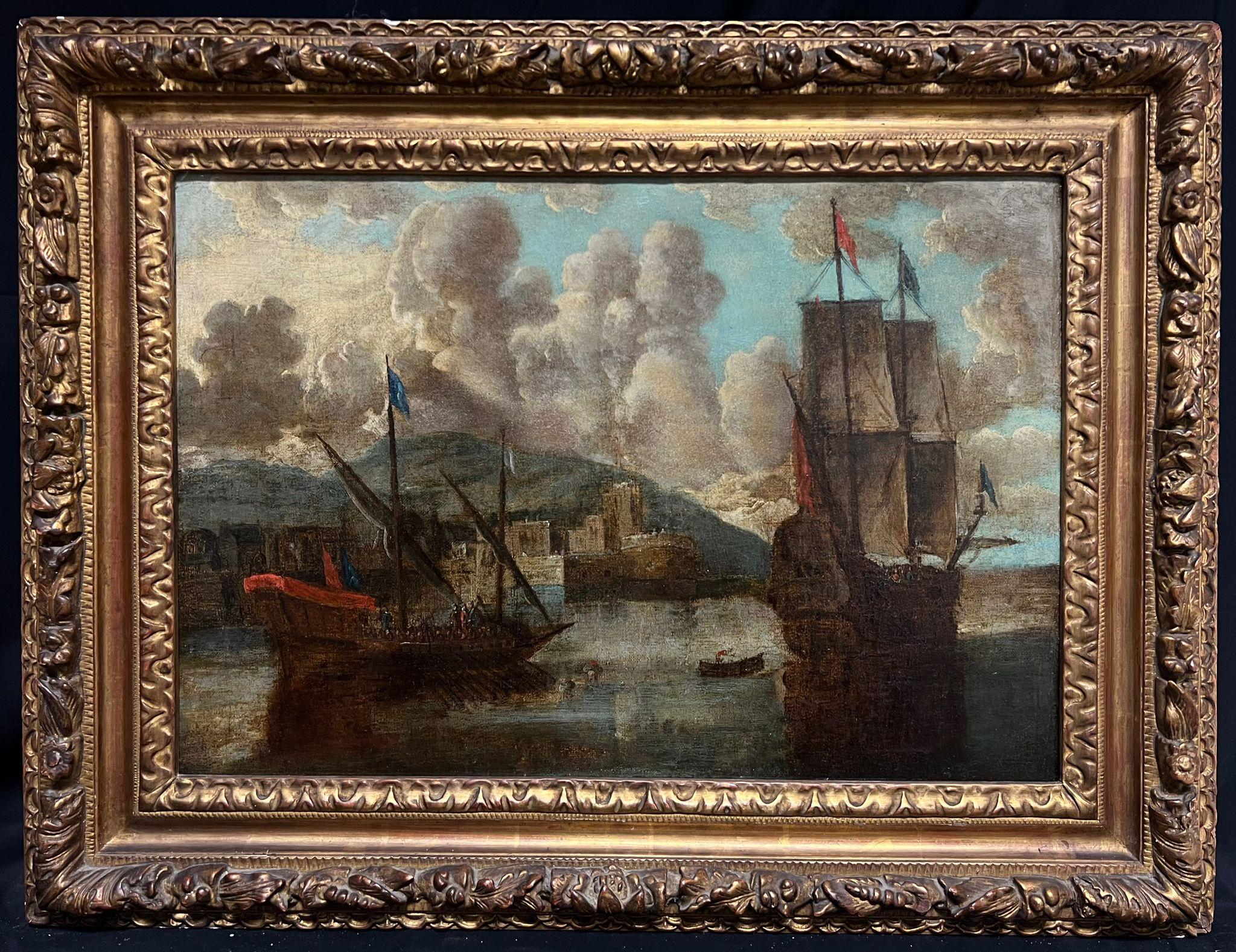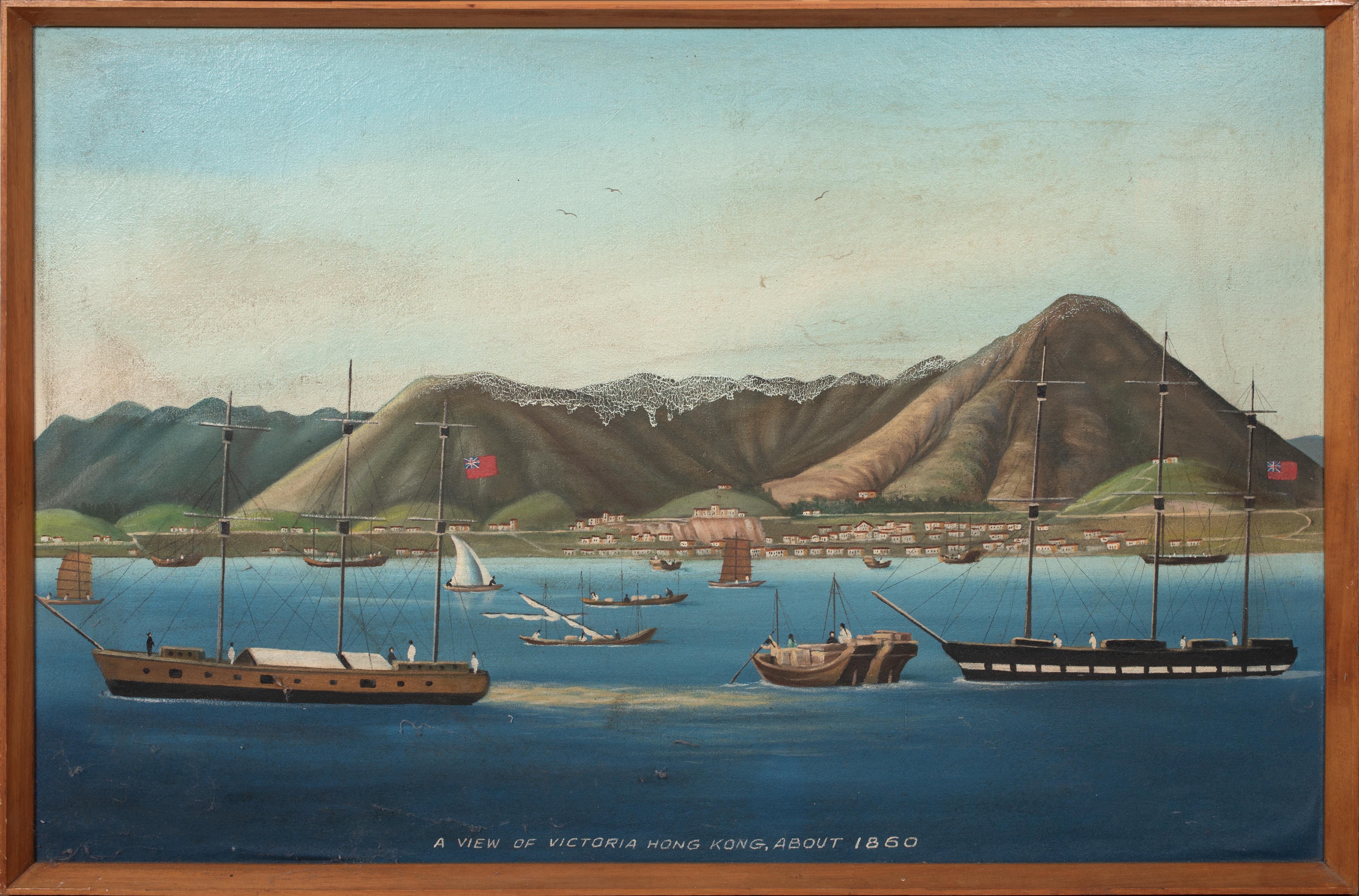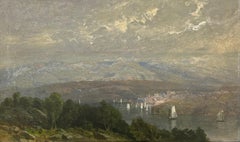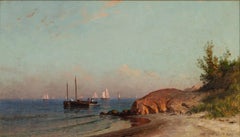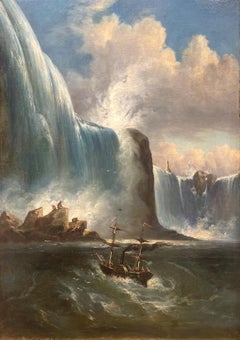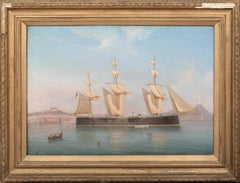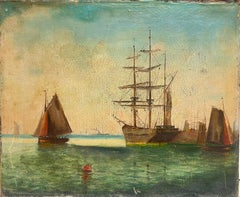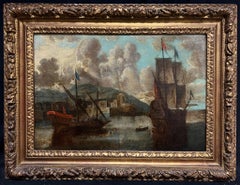Items Similar to "Harbour of Rio de Janeiro, Brazil, " Julius Montalant, Maritime Port Trade
Want more images or videos?
Request additional images or videos from the seller
1 of 7
Julius Montalant"Harbour of Rio de Janeiro, Brazil, " Julius Montalant, Maritime Port Trade1850
1850
$9,600
$12,00020% Off
£7,339.71
£9,174.6420% Off
€8,453.86
€10,567.3320% Off
CA$13,452.54
CA$16,815.6820% Off
A$15,018.50
A$18,773.1220% Off
CHF 7,869.47
CHF 9,836.8420% Off
MX$183,841.18
MX$229,801.4720% Off
NOK 99,942.32
NOK 124,927.9020% Off
SEK 94,232.92
SEK 117,791.1520% Off
DKK 63,092.06
DKK 78,865.0720% Off
Shipping
Retrieving quote...The 1stDibs Promise:
Authenticity Guarantee,
Money-Back Guarantee,
24-Hour Cancellation
About the Item
Julius Montalant (1823 - 1898)
Harbour of Rio Janeiro, 1843-1850
Oil on canvas
17 x 24 inches
Signed and dated lower right; conservator's inscription on the reverse
Born in Virginia, probably Norfolk, Julius Montalant is known for his drawings and paintings inspired by his travels on board navy ships. Attached to the USS St. Louis around 1844-45, he sketched ports of call he visited, including Brazil, Chile, New Zealand, Australia, and China. Many of his works are held in the Museum of the U.S. Naval Academy. Navy records indicate his rank as 'C. Clerk', which may mean that he held a civilian position.
During the 1850s he lived in Philadelphia, and in 1851-61 he exhibited at the Philadelphia Art Union and the Pennsylvania Academy of the Fine Arts. Included were paintings of North America, Greece, China, France, Italy, and South America. The 'tropical' scenes were apparently based on sketches done on board the USS St. Louis.
In 1858 he traveled to Rome, and is recorded to have studied with J.B. Durand-Brager in 1864. He made Rome his base until his death in 1878.
- Creator:Julius Montalant (1823 - 1898, American)
- Creation Year:1850
- Dimensions:Height: 21.25 in (53.98 cm)Width: 28.5 in (72.39 cm)
- Medium:
- Movement & Style:
- Period:
- Condition:
- Gallery Location:New York, NY
- Reference Number:1stDibs: LU184129925142
About the Seller
5.0
Platinum Seller
Premium sellers with a 4.7+ rating and 24-hour response times
Established in 2022
1stDibs seller since 2022
115 sales on 1stDibs
Typical response time: <1 hour
- ShippingRetrieving quote...Shipping from: New York, NY
- Return Policy
Authenticity Guarantee
In the unlikely event there’s an issue with an item’s authenticity, contact us within 1 year for a full refund. DetailsMoney-Back Guarantee
If your item is not as described, is damaged in transit, or does not arrive, contact us within 7 days for a full refund. Details24-Hour Cancellation
You have a 24-hour grace period in which to reconsider your purchase, with no questions asked.Vetted Professional Sellers
Our world-class sellers must adhere to strict standards for service and quality, maintaining the integrity of our listings.Price-Match Guarantee
If you find that a seller listed the same item for a lower price elsewhere, we’ll match it.Trusted Global Delivery
Our best-in-class carrier network provides specialized shipping options worldwide, including custom delivery.More From This Seller
View All"West Point" John Ferguson Weir, Hudson River School Landscape with Sailboats
By John Ferguson Weir
Located in New York, NY
John Ferguson Weir
West Point, 1873
Signed and dated lower left
Oil on panel
12 1/8 x 20 1/8 inches
Provenance:
Sotheby's Arcade, American Paintings, December 19, 2003, Lot 1091
Spanierman Gallery, New York
Private Collection, New York (acquired directly from the above)
Exhibited:
Roslyn, Nassau County Museum of Fine Art, William Cullen Bryant, The Weirs and American Impressionism, April 24, 1983-July 31, 1983.
A painter, sculptor, writer, and teacher, John Weir was a highly talented man whose painting was overshadowed by his father, Robert Weir, the long-time West Point Academy drawing teacher, and his brother, J Alden Weir, well-known impressionist painter.
His distinguished reputation was primarily based on his accomplishments as a teacher and administrator. For many years, from 1869 to 1913, John Weir was the Director of the Yale University School of Fine Arts. He was also a commissioner of the art exhibition at the Centennial Exposition in Philadelphia.
Weir was born at West Point, New York, and by age 20, had a studio in New York City in the Tenth Street Studio Building, the first building in America dedicated to art studios, and there he associated with many leading painters of the day.
He earned attention early in his career for paintings of industrial scenes...
Category
1870s Hudson River School Landscape Paintings
Materials
Oil, Panel
"Sailboats in a Bay" John Ross Key, American Landscape, Skyscape, Maritime Scene
By John Ross Key
Located in New York, NY
John Ross Key
Sailboats in a Bay
Signed lower right
Oil on canvas
15 x 26 inches
Provenance
Private collection, St. Simon's Island, Georgia
Private Collection, by descent
Private Co...
Category
1870s Academic Figurative Paintings
Materials
Canvas, Oil
"Ship Portrait, " William Edward Norton, Seascape Maritime Painting, New England
By William Edward Norton
Located in New York, NY
William Edward Norton (1843 - 1916)
Ship Portrait, 1876
Oil on canvas
10 x 16 inches
Signed and dated lower left
Born in Boston, William Norton became a noted marine painter, stirred by his youth when he sailed on family-owned ships. He studied at the Lowell Institute in Boston, and with George Inness, and then established a studio in Boston.
In the early 1870s, he went to Paris and became a student with Chevreuse and A. Vollon, and then he settled in London where he exhibited throughout the last quarter of the 19th century. His reputation there was based on his scenes of the Thames River, and ocean and coastal views.
In 1901, he and his wife returned to the United States and settled in New York City. He also painted at Monhegan Island, Maine, where a treacherous ledge on the southern side of the island is named "Norton's Ledge" for him.
He was a member of the Boston Art Club with whom he exhibited from 1873 to 1909. He also exhibited with the Pennsylvania Academy, the Royal Academy in London, the Paris Salon, the 1893 Chicago Exposition...
Category
1870s Hudson River School Landscape Paintings
Materials
Canvas, Oil
"Niagara Falls" Victor de Grailly, Hudson River School, New York Landscape
By Victor de Grailly
Located in New York, NY
Victor de Grailly
Niagara Falls, circa 1840-45
Oil on canvas
28 7/8 x 21 1/4 inches
Provenance:
Mark Borghi Fine Art, New York
Private Collection, Nyack, New York
Little is known a...
Category
1840s Hudson River School Landscape Paintings
Materials
Canvas, Oil
"Grand Manan" Harrison Bird Brown, Maine Landscape, Hudson River School Seascape
By Harrison Bird Brown
Located in New York, NY
Harrison Bird Brown (1831 - 1915)
Grand Manan
Oil on canvas
12 x 20 inches
Signed with initials lower left
Harrison Bird Brown was born in 1831 in Portland, Maine, and is best known for his White Mountain landscapes and marine paintings of Maine's Casco Bay...
Category
Late 19th Century Hudson River School Landscape Paintings
Materials
Canvas, Oil
"Western Lake Landscape, " John Fery, Hudson River School View
By John Fery
Located in New York, NY
John Fery (1859 - 1934)
Western Lake Landscape, circa 1920
Oil on canvas
21 x 23 1/4 inches
Signed lower left
Provenance:
Private Collection, New York
Born in Austria, John Fery earned a strong reputation for dramatic paintings of western mountain landscape in the United States. Glacier National Park in northwest Montana was a popular subject for him.
He was raised in a prominent, wealthy family that lived on an estate about nineteen miles northeast of Salzburg. His mother was Hungarian, and his father was born in Bohemia. S ome sources have written that he studied art in Dusseldorf, Germany with Peter Jansen, and also in Munich, Venice and Karlsruhe. But his "name does not appear in the records of the major art schools in any of these places, nor is there any record of his name at either the Vienna or Budapest academies." (Merrill 26) It is possible, however, that he received private instruction, and because of the sophistication of his painting, sources think it unlikely that he was self taught.
An early interest in wilderness scenery led him to painting American landscapes and hunting scenes. In the mid 1880s, he came to America and lived in the German community in Milwaukee, and then in 1886, brought his family to the United States. His wife, Mary Rose Kraemer (1862-1940), was born in Switzerland, and they had one child born near Munich and two others born in the United States. From 1886 to 1888, they lived in New York, and by 1890, Fery had made his first trip West.
He visited Yellowstone Park in 1891, and indicated in his writings that he had been there even earlier. From 1892 to 1893, he led European nobility on hunting expeditions to the American Northwest, made possible by the completion of the Northern Pacific Railroad...
Category
1920s Hudson River School Landscape Paintings
Materials
Canvas, Oil
$9,600 Sale Price
20% Off
You May Also Like
British Royal Navy Anchored Off Naples, 19th Century TOMMASO DE SIMONE
Located in Blackwater, GB
British Royal Navy HMS Encounter Anchored Off Naples, 19th Century
TOMMASO DE SIMONE (1805-1888)
Large 19th Century view of the British Royal Navy fleet off the coast of Naples, oi...
Category
19th Century Landscape Paintings
Materials
Canvas, Oil
$4,245 Sale Price
35% Off
Antique English Oil Painting Classic Tall Ships Marine Harbour Scene Sunrise
Located in Cirencester, Gloucestershire
English School, late 19th century
oil on canvas, unframed
faint signature
painting: 15 x 18 inches
provenance: private collection
condition: overall good and sound condition, some ol...
Category
Late 19th Century Victorian Landscape Paintings
Materials
Oil, Canvas
18th-Century Old Master Painting Harbor Scene with Tall Ships & Fortifications
Located in Cirencester, Gloucestershire
The Fortified Harbour
French School, circa 1700's
oil on canvas, framed in antique carved gilt wood frame
Framed: 21.5 x 28.5 inches
Canvas : 15 x 22 inches
Provenance: private colle...
Category
Early 18th Century Old Masters Landscape Paintings
Materials
Oil
Antique Maritime Ships Oil Painting "British Fleet Bay of Naples" Signed & Dated
Located in Portland, OR
An important antique Maritime ships oil on canvas painting of " The British Fleet in the Bay of Naples", by Tommaso De Simone (1805-1888), signed & dated 1860.
The painting depicts t...
Category
1860s Italian School Landscape Paintings
Materials
Oil, Canvas
Trade Ships Off Victoria Harbour, Hong Kong, 1860 Chinese School 19th Century
Located in Blackwater, GB
Trade Ships Off Victoria Harbour, Hong Kong, 1860
Chinese School
Large 19th Century Chinese School view of trade ships off Victoria, Hong Kong, oil on board. Excellent quality and ...
Category
19th Century Landscape Paintings
Materials
Oil, Board
$2,211 Sale Price
35% Off
18th Century French Old Master Oil Painting Ancient Port Harbor Shipping Marine
Located in Cirencester, Gloucestershire
Harbor Scene
Circle of Claude Joseph Vernet (French, 1714-1789)
oil painting on canvas, framed in antique gilt frame
framed: 20.5 x 25.5
canvas: 19 x 23.5 inches
condition: very good...
Category
18th Century Old Masters Landscape Paintings
Materials
Oil, Canvas
